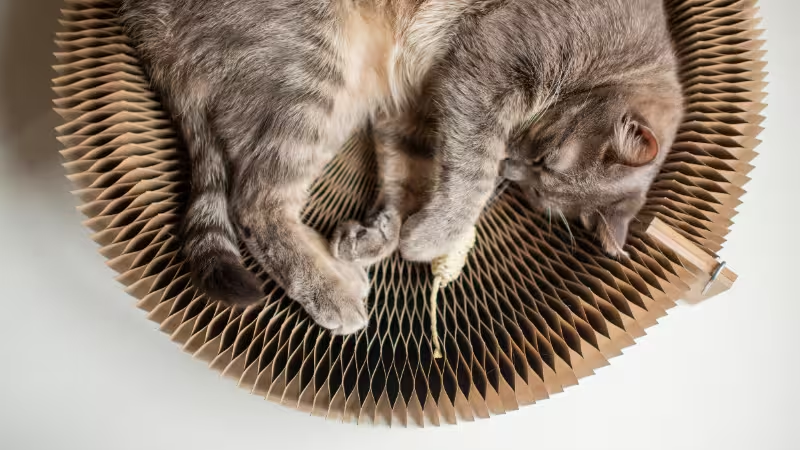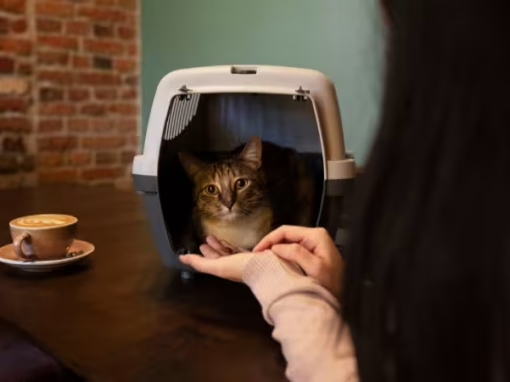Keeping your cat indoors ensures safety from traffic, predators, and disease, but it can also lead to boredom and frustration if their environment isn’t engaging. Enrichment for indoor cats is essential to maintain their physical health and mental wellbeing. By recreating the challenges and stimulation they’d experience outdoors, you can help your cat thrive, not just survive.
Table of Contents
Understanding Why Enrichment Is Important
Indoor cats live longer, safer lives than outdoor cats, yet the trade-off is often a lack of mental and physical stimulation. Cats are natural hunters and explorers with strong instincts to stalk, pounce, climb, and scratch. When these needs aren’t met, they can develop undesirable behaviours like scratching furniture, overeating, or aggression.
Enrichment helps satisfy your cat’s instinctual drives, reduces stress, and prevents behavioural problems. It’s also vital for their physical fitness, keeping obesity and related illnesses at bay.
Creating a Stimulating Environment
Designing a Cat-Friendly Home
A stimulating home environment begins with giving your cat vertical and horizontal spaces to explore. Cat trees, wall shelves, and window perches provide climbing opportunities and safe observation points. Cats love high vantage points where they can survey their territory, much like they would in the wild.
Adding scratching posts of different materials—such as sisal, cardboard, or carpet—encourages natural scratching behaviour while saving your furniture. Position these near favourite resting spots or entryways to make them irresistible.
The Importance of Hiding Spots and Rest Areas
Cats need quiet spaces to retreat when they feel overwhelmed. Create cosy hiding spots using boxes, covered beds, or even a blanket over a chair. This helps them feel secure and supports their natural instinct to observe from a concealed place.
Encouraging Play and Physical Activity
Interactive Toys and Games
Toys are the foundation of enrichment for indoor cats. Wand toys that mimic prey, like feather teasers or fabric ribbons, are ideal for engaging your cat’s hunting instincts. Rotate toys regularly to prevent boredom and introduce new textures and movements to maintain interest.
Laser pointers can stimulate chasing instincts but should always be paired with a physical toy or treat at the end to give your cat a sense of “catching” their prey.
Puzzle Feeders and Hunting Games
One of the most effective ways to enrich your cat’s day is by making them “work” for their food. Puzzle feeders, treat-dispensing balls, or hiding kibble around the house turn mealtime into an exciting scavenger hunt.
This form of enrichment provides both mental and physical stimulation while encouraging natural hunting behaviour. It also helps slow down fast eaters, improving digestion and reducing overeating.
Promoting Mental Stimulation
Training and Clicker Exercises
Training isn’t just for dogs—cats are intelligent and can learn a wide range of cues through positive reinforcement. Using a clicker or treats, you can teach your cat to sit, come when called, or even give a high-five.
These exercises build confidence, strengthen the bond between you and your cat, and challenge their mind. Keeping training sessions short and fun ensures your cat stays interested and engaged.
Sensory Stimulation Through Scent and Sound
Cats rely heavily on scent and sound to interpret their environment. Providing safe sensory experiences—like cat-safe herbs (valerian, silvervine, or catnip)—can enhance their wellbeing.
Playing gentle music or nature sounds can also relax anxious cats, while outdoor noises from an open window (with a secure screen) keep them mentally stimulated.
Simulating the Outdoors Indoors
Window Views and Birdwatching
Cats are natural observers, and a view of the outdoors can provide endless entertainment. Position a perch or cat tree near a secure window so your cat can watch birds, squirrels, or passing people. Adding a bird feeder outside the window enhances this experience, giving them a constant “show” to watch safely from indoors.
Safe Outdoor Adventures
For cats that crave exploration, consider harness training or setting up a secure “catio” (cat patio). A catio allows your feline to enjoy fresh air, sunshine, and outdoor sights while remaining protected from harm.
Harness walks can also be enriching, but they should always be introduced gradually and supervised to ensure safety.
Social and Emotional Enrichment
Human Interaction and Bonding
Social connection plays a crucial role in enrichment for indoor cats. Dedicate daily time to play, grooming, or simply sitting with your cat. These moments strengthen your bond and reduce feelings of isolation or anxiety.
Cats are social in their own way, and while some enjoy constant companionship, others prefer short bursts of interaction. Learn your cat’s preferences and respect their boundaries for a happier coexistence.
Multi-Cat Environments
If you have multiple cats, enrichment becomes even more important to reduce tension and competition. Provide multiple litter boxes, food stations, and resting areas to prevent territorial disputes. Engage them in group play sessions to encourage healthy social behaviour.
DIY Enrichment Ideas
Homemade Toys and Activities
You don’t need to spend a fortune to keep your cat entertained. Many enriching toys can be made at home with simple materials. Crumpled paper balls, cardboard boxes, or toilet paper rolls filled with treats can provide hours of fun.
Building tunnels or forts from cardboard boxes can also mimic hunting environments and satisfy your cat’s curiosity. Rotate DIY toys often to keep playtime exciting and new.
Feeding Variety and Exploration
Try introducing different feeding stations around your home. This encourages exploration and mimics the experience of hunting multiple small prey. Using varied textures, scents, and meal setups keeps feeding time fresh and engaging.
Supporting Your Cat’s Emotional Wellbeing
Enrichment isn’t only about physical activity—it’s about creating a balanced emotional environment. Pay attention to your cat’s reactions and adapt enrichment techniques to their personality.
Shy cats may prefer calm, predictable routines and quiet toys, while confident cats might enjoy challenges like puzzle boxes or agility setups. Observing and responding to these cues helps you fine-tune their enrichment to suit their individual temperament.
Maintaining Long-Term Engagement
Cats thrive on variety, so refresh their environment regularly. Rotate toys, rearrange climbing structures, or introduce new scents to keep things interesting. Consistent but varied stimulation helps maintain curiosity and prevents boredom from setting in.
Remember, enrichment for indoor cats is an ongoing commitment to your feline’s wellbeing. By nurturing their instincts, stimulating their senses, and providing emotional support, you’ll ensure your indoor cat leads a fulfilled and joyful life.



